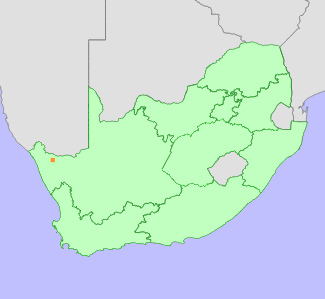|
Scientific Name | Conophytum tantillum N.E.Br. subsp. eenkokerense (L.Bolus) S.A.Hammer |
Higher Classification | Dicotyledons |
Family | AIZOACEAE |
Synonyms | Conophytum eenkokerense L.Bolus, Conophytum marginatum Lavis var. eenkokerense (L.Bolus) Rawé |
National Status |
Status and Criteria | Endangered A4acd; B1ab(iii,v)+2ab(iii,v) |
Assessment Date | 2021/12/09 |
Assessor(s) | A.J. Young, P.G. Desmet, D. Guo, A. Harrower, L. Jabar, L. Knoetze, C. Rodgerson, P.C.V. Van Wyk, N.N. Mhlongo & I. Ebrahim |
Justification | This succulent is endemic to the Northern Cape province of South Africa with an extent of occurrence (EOO) and area of occupancy (AOO) of 12 km2. The population is in decline due to illegal collection for the international trade in ornamental succulents since 2019. Illegal collection is likely to increase as there has been a dramatic increase in the number of species and volume of plants targeted since 2019 including many from the immediate area. The continued threat of illegal collection is therefore regarded as extremely high for this particular taxon. The limited number of locations across a small geographic range makes the taxon very susceptible to very rapid declines. A decline of up to 75% of the population is very likely within the next three generations (90 years). Loss of vegetation cover has been observed at this site via Landsat imagery between 1984 and 2018 and is used to infer that the habitat quality is already in decline. Anthropogenic climate change is a major threat to this succulent. Modelling of climate change impacts is predicted to result in an average loss of 75% of suitable bio-climatic habitat by 2080 under likely CO2 emission scenarios (RCP 2.6). It therefore qualifies as Endangered under criteria A4 and B1+2. |
Distribution |
Endemism | South African endemic |
Provincial distribution | Northern Cape |
Range | This succulent is endemic to the Northern Cape Province of South Africa where it is only found in three locations with a restricted geographic range. |
Habitat and Ecology |
Major system | Terrestrial |
Major habitats | Bushmanland Arid Grassland |
Description | This taxon is known from the Richtersveld and Bushmanland & West Griqualand bioregions of the Succulent Karoo and Nama Karoo biomes. The plants are found, often in dense stands, on isolated quartz-rich hills. Plants are typically in the partial shade afforded by larger shrubs and rocks.
This succulent has a generation length of 30 years. It is expected to be sensitive to the impacts of climate change as it does not disperse and while adapted to arid conditions, is dependent on limited seasonal rainfall. Species in the genus are sensitive to long periods of drought. Drought related mortality has been observed for other closely related taxa within the genus. |
Threats |
| This succulent is currently threatened by illegal collection for the international trade in ornamental succulents. The plants are range-restricted which renders them highly susceptible to a rapid decline in number through collection or other adverse events. A population decline of 50-75% is suspected over three generations (90 years) as a result of this activity.
Anthropogenic climate change is a long-term threat to this succulent. Climate models for the likely emission scenarios where emissions stay at present day levels (RCP 2.6) (Hausfather and Peters 2020) and worst case scenarios where emissions continue to increase during the 21st century (RCP 8.5) indicate that there will be a loss of suitable bioclimatic envelope of between 75% and 99% by 2080 for this taxon. Species in this genus have limited dispersal ability and migration to suitable habitats elsewhere is regarded as highly unlikely. |
Population |
There are no formal estimates of population size for this taxon but the number of mature individuals is likely to be fewer than 10,000. The population is experiencing initial levels of decline due to illegal collection for the ornamental succulent plant trade.
|
Population trend | Decreasing |
Assessment History |
Taxon assessed |
Status and Criteria |
Citation/Red List version | | Conophytum tantillum N.E.Br. subsp. eenkokerense (L.Bolus) S.A.Hammer | Rare | Raimondo et al. (2009) | |
Bibliography |
Hammer, S. 2002. Dumpling and his wife: New view of the genus Conophytum. EAE Creative Colour, Norwich.
Hammer, S.A. 1993. The genus Conophytum: A conograph. Succulent Plant Publications, Pretoria.
Hausfather, Z. and Peters, G.P. 2020. Emissions - the 'business as usual' story is misleading. Nature 577(618-620).
Opel, M.R. 2004. The rediscovery of Crassula alcicornis. Haseltonia 10:38-40.
Raimondo, D., von Staden, L., Foden, W., Victor, J.E., Helme, N.A., Turner, R.C., Kamundi, D.A. and Manyama, P.A. 2009. Red List of South African Plants. Strelitzia 25. South African National Biodiversity Institute, Pretoria.
|
Citation |
| Young, A.J., Desmet, P.G., Guo, D., Harrower, A., Jabar, L., Knoetze, L., Rodgerson, C., Van Wyk, P.C.V., Mhlongo, N.N. & Ebrahim, I. 2021. Conophytum tantillum N.E.Br. subsp. eenkokerense (L.Bolus) S.A.Hammer. National Assessment: Red List of South African Plants version 2024.1. Accessed on 2025/12/02 |
 Comment on this assessment
Comment on this assessment


